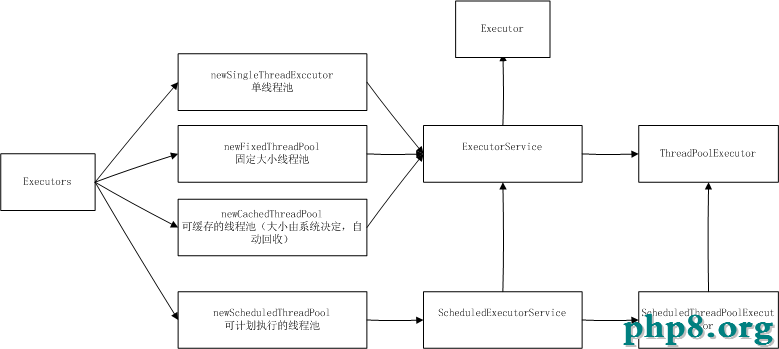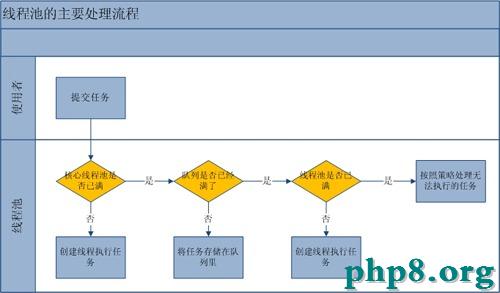Java 線程池框架。本站提示廣大學習愛好者:(Java 線程池框架)文章只能為提供參考,不一定能成為您想要的結果。以下是Java 線程池框架正文
一、線程池構造圖

二、示例
定義線程接口
public class MyThread extends Thread {
@Override
publicvoid run() {
System.out.println(Thread.currentThread().getName() + "正在執行");
}
}
1:newSingleThreadExecutor
ExecutorService pool = Executors. newSingleThreadExecutor(); Thread t1 = new MyThread(); Thread t2 = new MyThread(); Thread t3 = new MyThread(); //將線程放入池中停止執行 pool.execute(t1); pool.execute(t2); pool.execute(t3); //封閉線程池 pool.shutdown();
輸出後果:
pool-1-thread-1正在執行 pool-1-thread-1正在執行 pool-1-thread-1正在執行
2:newFixedThreadPool
ExecutorService pool = Executors.newFixedThreadPool(3); Thread t1 = new MyThread(); Thread t2 = new MyThread(); Thread t3 = new MyThread(); Thread t4 = new MyThread(); Thread t5 = new MyThread(); //將線程放入池中停止執行 pool.execute(t1); pool.execute(t2); pool.execute(t3); pool.execute(t4); pool.execute(t5); pool.shutdown();
輸出後果:
pool-1-thread-1正在執行 pool-1-thread-2正在執行 pool-1-thread-1正在執行 pool-1-thread-2正在執行
3 :newCachedThreadPool
ExecutorService pool = Executors.newCachedThreadPool(); Thread t1 = new MyThread(); Thread t2 = new MyThread(); Thread t3 = new MyThread(); Thread t4 = new MyThread(); Thread t5 = new MyThread(); //將線程放入池中停止執行 pool.execute(t1); pool.execute(t2); pool.execute(t3); pool.execute(t4); pool.execute(t5); //封閉線程池 pool.shutdown();
輸出後果:
pool-1-thread-2正在執行 pool-1-thread-4正在執行 pool-1-thread-3正在執行 pool-1-thread-1正在執行 pool-1-thread-5正在執行
4 :ScheduledThreadPoolExecutor
ScheduledExecutorService pool = Executors.newScheduledThreadPool(2);
pool.scheduleAtFixedRate(new Runnable() {//每隔一段時間就觸發異常
@Override
public void run() {
//throw new RuntimeException();
System.out.println("================");
}
}, 1000, 2000, TimeUnit.MILLISECONDS);
pool.scheduleAtFixedRate(new Runnable() {//每隔一段時間打印零碎時間,證明兩者是互不影響的
@Override
public void run() {
System.out.println("+++++++++++++++++");
}
}, 1000, 2000, TimeUnit.MILLISECONDS);
輸出後果:
================ +++++++++++++++++ +++++++++++++++++ +++++++++++++++++
三、線程池中心參數
corePoolSize : 池中中心的線程數
maximumPoolSize : 池中允許的最大線程數。
keepAliveTime : 當線程數大於中心時,此為終止前多余的閒暇線程等候新義務的最長時間。
unit : keepAliveTime 參數的時間單位。
workQueue : 執行前用於堅持義務的隊列。此隊列僅堅持由 execute辦法提交的 Runnable義務。
threadFactory : 執行順序創立新線程時運用的工廠。
handler : 由於超出線程范圍和隊列容量而使執行被阻塞時所運用的處置順序。
ThreadPoolExecutor :Executors類的底層完成。
3.1 義務排隊機制
SynchonousQueue: 同步隊列,隊列直接提交給線程執行而不堅持它們,此時線程池通常是無界的
LinkedBlockingQueue: 無界對列,當線程池線程數到達最大數量時,新義務就會在隊列中等候執行,能夠會形成隊列有限收縮
ArrayBlockingQueue : 有界隊列,有助於避免資源耗盡,一旦到達下限,能夠會形成新義務喪失
留意:
newSingleThreadExecutor、newFixedThreadPool運用的是LinkedBlockingQueue
newCachedThreadPool 運用的是 SynchonousQueue
newScheduledThreadPool運用的是 DelayedWorkQueue
3.2 線程執行流程

3.3 線程大小確定:
cpu密集型: 盡量少開線程,最佳線程數 Ncpu+1
io密集型:多開線程,2Ncpu
混合型:依據狀況而定,可以拆分紅io密集和cou密集
以上就是本文的全部內容,希望本文的內容對大家的學習或許任務能帶來一定的協助,同時也希望多多支持!